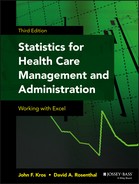Book Description
The must-have statistics guide for students of health servicesStatistics for Health Care Management and Administration is a unique and invaluable resource for students of health care administration and public health. The book introduces students to statistics within the context of health care, focusing on the major data and analysis techniques used in the field. All hands-on instruction makes use of Excel, the most common spreadsheet software that is ubiquitous in the workplace. This new third edition has been completely retooled, with new content on proportions, ANOVA, linear regression, chi-squares, and more, Step-by-step instructions in the latest version of Excel and numerous annotated screen shots make examples easy to follow and understand.
Familiarity with statistical methods is essential for health services professionals and researchers, who must understand how to acquire, handle, and analyze data. This book not only helps students develop the necessary data analysis skills, but it also boosts familiarity with important software that employers will be looking for.
- Learn the basics of statistics in the context of Excel
- Understand how to acquire data and display it for analysis
- Master various tests including probability, regression, and more
- Turn test results into usable information with proper analysis
Statistics for Health Care Management and Administration gets students off to a great start by introducing statistics in the workplace context from the very beginning.
